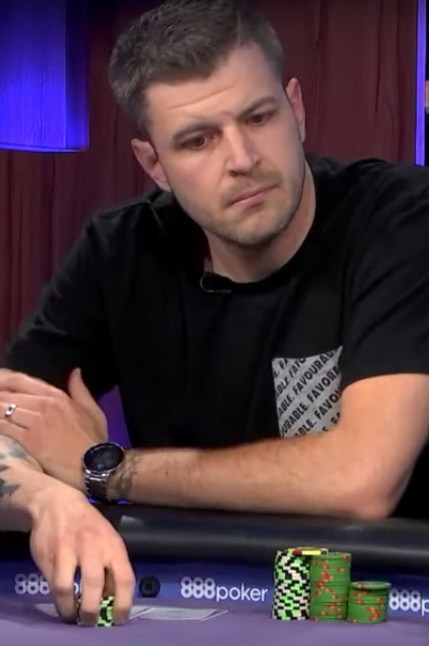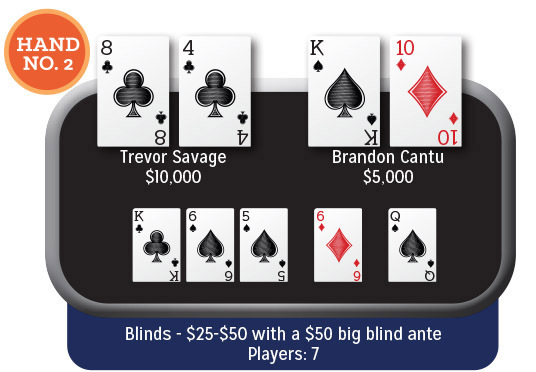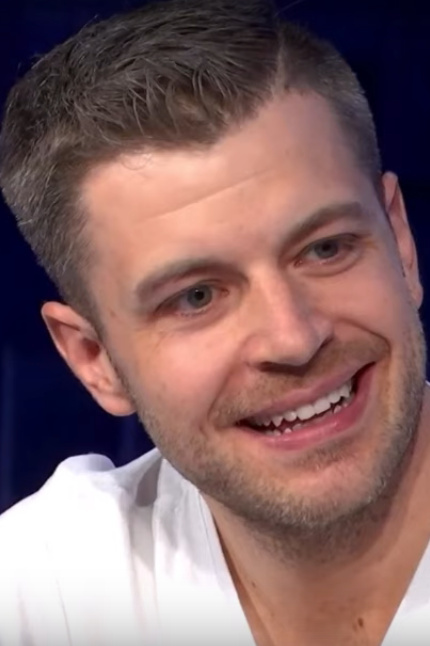






Poker Strategy: High-Stakes Pro Trevor Savage Breaks Down Cash Game HandsPoker Vlogger Takes Card Player Through His Thought Process During His Poker After Dark Session |
|
|

For most of his poker career, Trevor Savage flew under the radar and quietly made a living playing high-stakes cash games online and live. Just over a year ago, however, Savage started a poker vlog called “Raising The Nuts” that documents his life as a poker pro and father of three.
His vlogs have become immensely popular among the poker community for both the high-stakes hand breakdowns and the comedy skits put on by Savage’s children. Despite making a living as a cash-game specialist, Savage also has tournament cashes dating back to 2006 and has racked up more than $530,000 in live earnings.
A couple months ago Savage was invited to play in a Poker After Dark cash game, where he played $25-$50 no-limit hold’em with a lineup featuring Justin Young, Mike Matusow, Barry Woods, Brandon Cantu, Jeff Platt, and Brandon Schaefer. The 36-year-old sat down with Card Player to discuss his thought process from two hands he played on stream.
Hand 1

Concepts: Using strong hands to bluff-catch against aggressive opponents.
The Action: Trevor Savage raised to $200 from under the gun, Barry Woods called on his direct left, and Brandon Cantu called out of the big blind. On the flop Cantu checked, Savage bet $400, Woods called, and Cantu folded. On the turn, Savage checked, Woods bet $800, and Savage called. Savage checked the river, and Woods bet $2,200. Savage called.
Steve Schult: I wanted to touch on your preflop raise. Is four times the blind your standard? I know you play a decent amount of online poker where the standard is three times the blind. Is this just different for live poker or dependent on the lineup you were in?
Trevor Savage: The game was playing with a big blind ante, so with that in effect, I’m going to be making it a little bit larger. Also, given the lineup, and especially with Brandon [Cantu] in the big blind, I was going to be opening a tighter range and so I was going to go with a larger sizing when I opened.
It’s definitely not the standard, but I think with the ante in play, it’s a little bit more standard. But specifically, with that lineup and specifically when I’m in that position, I’m going to be opening a pretty tight range. And with Brandon in the big blind, I’m going to open to a little larger sizing because he’s going to defend wider.
SS: You get called by the two loosest players at the table. When you end up against two players that can have such a wide range, do you even try to start to narrow ranges or do you just end up playing your hand straightforwardly?

I actually thought, from a live read perspective, that Brandon might be a little tighter than normal. It was beginning of day 2 and he got beat up a little bit on day 1. I thought that he might come in and play a little differently than he did on day 1, just so he could stay in the game. But once they both call, their ranges are really wide.
I’m going to be in a spot post-flop where I’m in between both of them. So, I’m going to be doing a lot of checking or betting small and navigating from there.
SS: You mentioned you had a live read. With your mix of online and live experience, what are your general thoughts on making live reads? How do you decide how far you are going to deviate from your baseline strategy based on a read?
TS: I made a decision a while back. I played live for a long time. I kind of went back and forth. I started as a live player, then I transitioned to online in about 2007. And then between Black Friday and New Jersey online launching, I played live every day at Parx. When I started playing at Parx, I made a decision that I had played so many hands at that point that I would always just trust my gut instinct and just go with it.
I think it’s one of those things that is kind of formulated over a lot of experience and a long time of playing. You can kind of just pick up general habits and making stereotypes of certain players. If I’m playing against very tough players, I’m going to stick more to a baseline strategy.
The weaker the player is, the more live reads come into play because you can kind of make exploitative reads based on the way that they are acting. For instance, if I go play a $1-$2 or a $1-$3 game at a casino, I would be able to pick up a ton more information than if I were playing in a high-stakes environment with a ton of professionals.
SS: On the flop, you continuation bet about two-thirds of the pot. I’ve talked to a lot of guys that like to bet small on this flop because since they will be betting this board so often, they want to make it a smaller size. How did you come up with your flop sizing?

So often it’s going to be a spot where I get to check, see what Barry does, and if Barry bets, I’ll get to see what Barry does. If Barry checks, on the turn I’m going to have some very perfect information. If Brandon checks again, then I can delay c-bet as a bluff with a lot of hands or I can go two streets of value with some weaker A-X hands and things like that. So I chose the two-thirds sizing because I thought I was going to be a little bit tighter in this spot than normal and purely because I can exploit for value against two very wide ranges.
I think here I’ll be exploitatively betting some really strong value hands and bluff candidates. Like hands that have blockers to some strong top pair hands, like J-10 suited with a backdoor flush draw or the flush draw on the flop itself.
SS: What do you make of Barry’s float? Would you recommend that people mix in these floats with hands that have almost no equity into their game?
TS: I think there are spots where you can actually do it. I think his hand choice is okay just because it blocks A-Q and A-J, I guess, but it doesn’t have any really pure backdoors.
SS: Would it be more reasonable if he had a diamond in his hand?

I think a hand that could turn a two-way backdoor straight draw would be good too. A hand like 8-9 where you can turn a little bit more equity is good. I think his hand choice is just a little bit too wide. Especially if he’s considering at all that I would have a tighter range because I raised from under the gun and bet into two players. In general, floating zero-equity hands is really not going to be great.
SS: Cantu folds and you’re heads-up with Barry. At this point, what is your general game plan on turns and rivers?
TS: On cleaner runouts, I’m definitely going for three streets. There are going to be some runouts where I’m only going to go for two streets of value. On really good turn cards for me, I’m going to go for some really large sizings, but on flush cards and some other cards like a five, I might check and go for one more big street on river or induce bluffs on the turn.
I’m going to hopefully go for three streets, but at worst, I’ll go for two big streets. If it checks through on the turn, I’ll go for a large river size.
SS: When the flush card comes in on the turn, are you pretty much just planning on check-calling two streets as long as it doesn’t come running diamonds?
TS: On the turn, I was planning to check-call and then check-decide on the river, which is what ended up happening. It’s not a situation I’m in love with because he’s going to have a fair amount of flushes here and I don’t have any blockers to any flushes either. The ideal situation is for the turn to go check-check and then on the river, I’ll get to overbet pretty big and get called by worse A-X hands.
In this specific scenario, I think I just have to continue and then work in some live reads on the river.
Hand 2

Concepts: Assessing ranges and board textures to pick the correct bluff candidates.
The Action: Brandon Cantu raised to $200 from the cutoff and Trevor Savage called out of the big blind. On the flop, Savage checked, Cantu bet $300, and Savage called. Savage led out for $500 on the turn and was called by Cantu. Savage bet $1,200 on the river and Cantu called once again.
SS: Let’s start with preflop. Do you usually defend 8-4 suited out of the big blind?
TS: This is actually the first hand of day 1. It’s the first hand I ever played on televised live poker. Just a little backstory, I was very nervous going into the session. One was just because playing televised poker is a little nerve racking. But also in the past, I’ve dealt with anxiety and things like that, so just the idea that I had built myself up to be on the show. I knew a week beforehand that I was going to be on the show.
So, for that whole week, you kind of play out how things are going to go in your head and just end up psyching yourself up. This hand was actually really important for me.
I think the defend is pretty standard because of the big blind ante in there. Brandon’s range is pretty wide and I kind of just wanted to get in there and mix it up a little bit. From a purely EV standpoint, it was probably breakeven or whatever, but I wanted to take some of those spots and just get involved. I didn’t mind doing it with Brandon, who’s range I thought would be pretty wide.
SS: You spent a week envisioning how it was going to go. Were any of those situations in your head involving you playing 8-4 suited out of the big blind in your first hand?

Even though it didn’t work out, it kind of got the nerves out of me for a second. In game, I felt like my thought process was good, I followed through with what I wanted to do. I thought my line was good in game and it kind of just gave me confidence and I just moved on to the next hand locked in. It allowed me not to psyche myself out by just sitting there without being in action.
SS: You check-call the flop with a gutshot and backdoor clubs. This has got to be the bottom of your range, right?
TS: Yeah. Normally, I would check-raise this hand. I want to check-raise this hand a lot, but I would like to do it deeper. If Brandon was about $10,000 deep, I would check-raise the flop and just go bet-bet on most runouts. When he has this stack size, there are still merits to check-raising because you get a lot of immediate folds from some hands. And I guess you could still set up sizes to where you can bet turn and jam river, but it becomes less enjoyable because when stack sizes are this short, you tend to just get jams on flop or turns from other draws.
One of the merits to check-raising this hand is that you’re not blocking spades. So we want situations where we can check-raise flop, bet turn and jam river and have all those folds in there. Rather than have him have value hands that are continuing. I would prefer to check-raise hand with less equity, but has blockers to good top pairs like Q-J. It can turn some straight draws and things like that, but generally you’re not going to improve on the turn. And if you get jammed on the flop, then whatever, we move on.
I kind of want to realize some equity with the 8-4. I would definitely not be check-raising a hand like 8-7 because it has too much equity and it would suck to get jammed on.
SS: Since you don’t want to check-raise 8-7, then you wouldn’t be check-raising the nut flush draw?
TS: The nut flush draw is just ahead of his range too. With ace-high, I can navigate a little bit. I can get to the river with ace-high and show it down or improve to the nuts.
SS: On this board texture, are you only folding your complete misses? If you have any piece of this board, are you calling a flop bet?
TS: His range is going to be super wide, so with any kind of piece, I am going to be continuing and navigating from there.
SS: Why did you lead the turn?

So, this is generally a good spot to lead all of your range. That was theory wise. But after thinking about it, I didn’t like it. Given how wide Brandon opens, he probably has more 6-X hands than I do and also c-bets all of them as well, based on what I had observed. And then you can include the nut hands that are less frequent like K-K, K-6 and 5-5.
I think often times it will just go check-check on the turn and I can just bluff the river. I’ll still get him to fold hands like Q-J and stuff like that. I think those hands will just check back the turn and fold the river anyway.
SS: You get to the river which brings in the flush draw. When you lead the river, are you only representing a flush at this point? Is that a tough sell given your line as a whole?
TS: This is why I actually felt confident in game. I wanted to use a sizing that I would use with my 6-X hands as well. I thought I would bet all my 6-X hands, my flushes, I would check my kings, and I would obviously throw in traps as well with maybe some full houses like 5-5 or 6-5.
In game, I chose a sizing that I thought I would use with my 6-X hands and I also don’t think I have many bluffs when the river gets there on the river. After the game, I think this should be an exploitative, never-bluff spot on the river. I don’t think he has any hands that call turn and folds the river when the flush draw gets there as well.
